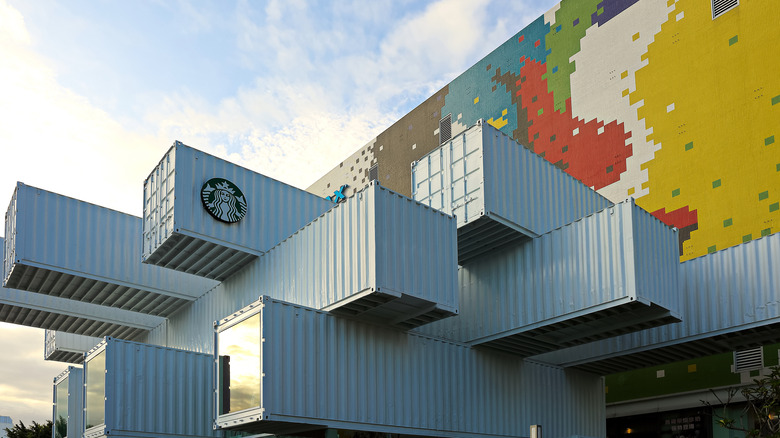What Makes This Starbucks In Taiwan Environmentally Unique
Starbucks is well known for having socially responsible goals and practices ranging from waste reduction to ethical sourcing, hunger relief, sustainability, civic engagement, job creation, and a host of other local initiatives as noted by Forbes. For a company that calls its workers "green apron partners," they set a pretty high bar, one that aims to strategically (and vastly) accelerate environmental-impact strategies by 2030, explains Fortune.
That sounds like an ambitious goal but considering that Starbucks had at least 33,000 stores in more than 80 countries by 2021 and holds the second-highest value for fast-service restaurants globally, second only to McDonald's, per Forbes. The company's founder, Howard Schultz, set the tone for what Chief Global Social Impact Officer Virginia Tenpenny told Forbes is like being part of "something bigger."
Early on, the company made investments in climate-tolerant coffee trees and renewable energy, per Fortune, and the commitments have progressed considerably since then. The 2030 goals for the company include reducing carbon emissions, landfill waste, and water withdrawal by 50% with Starbucks' objective to eventually become "resource positive." With all of the lofty goals and high-profile methods of achieving them, there's a lesser-known way that Starbucks stores are inching towards environmental uniqueness: store architecture. Here's a look at how that played out with one location in Taiwan.
Recycled materials for sustainable architecture
Amongst the thousands of Starbucks stores, it doesn't seem that one would stand out over the others. Starbucks often incorporates local culture into store designs, making each slightly different. But Starbucks Hualien Bay Mall in Taiwan has a specific defining feature: It's constructed from recycled, repurposed shipping containers. The company had 45 of these structures primarily in the United States by 2018, but this much larger version designed by Japanese architect Kengo Kuma is the first shipping container store in Asia Pacific, according to Starbucks Stories.
The company places this structure into its "Starbucks Greener Stores" category, which is committed to sustainable building. Twenty-nine shipping containers comprise 3,444 square feet of space spanning two levels, placed in rotating patterns to evoke a look similar to trees, explains Starbucks Taiwan. Calling it a porous "urban forest" design, the Kengo Kuma team believes recycled-container design is a prototype ushering in a new type of sustainable architecture and lightweight mobility.
Multiple skylights allow natural sunlight, and the design's natural storytelling based on where the containers traveled. One photograph reveals an inscription, along with stamped coordinates, stating that it traveled through three global ports before finally resting "under your feet and above your head" at this location.
As Eco Talk notes, repurposing shipping containers into usable structures saves space, resources, building materials, landfill overload, and costs. Even though Starbucks can likely afford to splurge on all of those things, it's good to know that the company aims not to.

